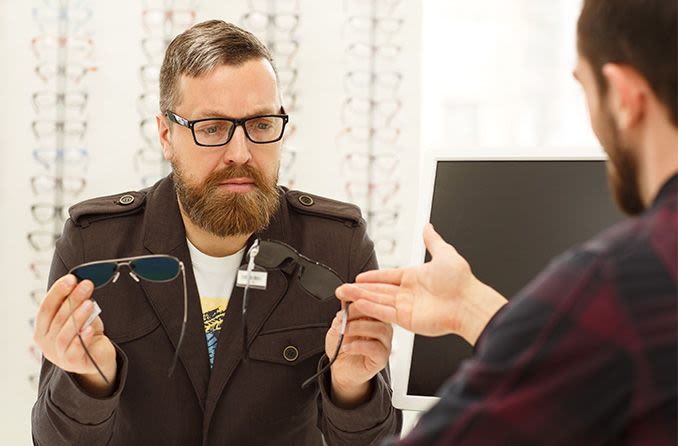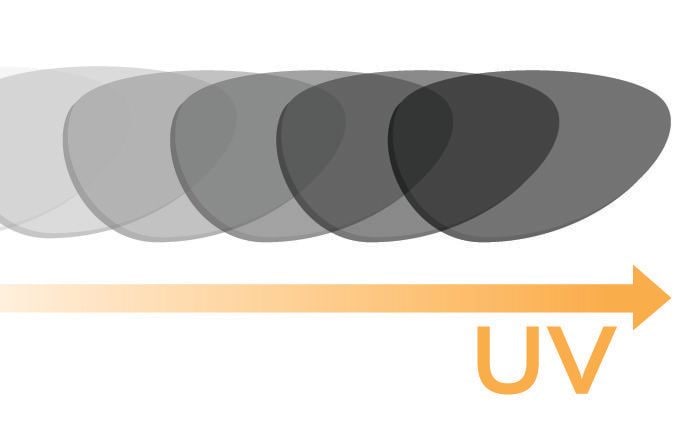What are the differences between photochromic and polarized lenses?
Photochromic and polarized lenses are two of the most popular ways to protect against the sun’s harmful ultraviolet (UV) rays, but there are important differences between the two.
We’ll help you decide which of these two well-known options is better for you.
What are photochromic lenses?
Photochromic lenses automatically get darker in the presence of sunlight, and are often referred to casually as transition lenses or transition glasses. Transitions lenses (with a capital “T”) are the most popular brand of photochromic lenses.
The big advantage of photochromic lenses is their versatility. People who wear them have essentially a pair of eyeglasses and sunglasses rolled into a single set of frames.
SEE RELATED: Photochromic lenses or prescription sunglasses?
What are polarized lenses?
Polarized lenses are primarily used to reduce the sun’s glare. They always come in the form of sunglasses, never eyeglasses, and they don’t transition back and forth.
People often use polarized sunglasses while driving on a bright day, since polarization reduces the glare coming from the road, windshield and other cars.
The big advantage of polarized sunglasses is their ability to improve driver safety and the ability to concentrate on the road.
Polarized sunglasses also can be used to reduce reflections from the surface of water, which makes them very popular for fishing and water-based recreational activities.
SEE RELATED: What are the advantages of polarized sunglasses?
Can photochromic lenses also be polarized?
It isn’t very common, but lenses that are both photochromic and polarized exist.
One example is the Transitions Vantage line of lenses. When these lenses darken in sunlight, they also become polarized. The darker the lenses get, the more powerful the polarization effect.
Are photochromic lenses better than polarized lenses?
This is definitely one of those “apples and oranges” questions. Determining whether photochromic lenses or polarized sunglasses are better truly depends on how you personally plan to use them.
Side by side, each style has its pros and cons. Some people might opt for a pair of each — a photochromic lenses for driving and polarized sunglasses for boating, for example.
Photochromic lenses could be the better choice if:
- You like the convenience of eyeglasses and sunglasses packaged into a single set of frames.
- You’re frequently moving from indoor to outdoor situations throughout the day.
- You don’t need sunglasses for daytime driving (or have a separate pair specifically for daytime driving).
- You do a lot of nighttime driving.
- Your eyes are sensitive to light (photophobia) and you’re looking for constant sun protection.
- You can afford the additional expense.
Polarized lenses could be the better choice if:
- You primarily wear contacts and non-prescription sunglasses.
- You don’t mind carrying a second pair of prescription glasses (if you usually wear eyeglasses instead of contacts).
- You want sunglasses in a style that is different from your everyday eyeglasses.
- You spend a lot of time driving during the day, and reducing sunlight glare is important to you.
- You’re on a tighter budget.
Both photochromic and polarized lenses can offer:
- 100% UV protection from potentially harmful UV rays. Double check your intended pair to make sure they offer either “100% UVA & UVB” or “UV 400” protection.
- Adequately darkened lenses for comfortable daytime vision.
- Prescription and non-prescription options. However, non-prescription photochromic lenses are much less common.
Both photochromic glasses and polarized sunglasses can correct vision and protect your eyes from the sun, but their differences are as clear as a summer day. Considering your lifestyle and talking to your optometrist can help you decide which option — or if owning one of each — is better for you.










